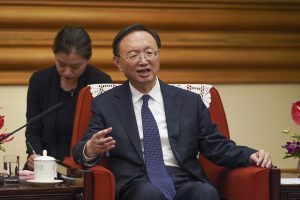China’s top diplomat, Yang Jiechi, visited Slovenia and Croatia after high-profile meetings with Russian counterparts earlier this week. Despite the flurry of attention paid to Yang’s Moscow visit, his stops in the Western Balkan states were generally overlooked. Yang, now the director of the Central Foreign Affairs Commission and a member of the Politburo, previously served as foreign minister and, before that, as Chinese ambassador to the United States. He is considered one of the major architects of contemporary Chinese foreign policy and while no landmark announcements appear to have emerged from his Balkan visits, his overseas trips still hold some symbolism.
But what led Yang to Slovenia and Croatia? The two countries are both members of the European Union (joining in 2004 and 2013, respectively). Separately, Slovenia and Croatia are not only members of the China-led “17+1” bloc, created to facilitate engagement between Beijing and Central and Eastern European countries, but have also embraced bilateral opportunities with China under the Belt and Road Initiative (BRI).
The economic relationships between Beijing and Ljubljana and Beijing and Zagreb have grown increasingly important and diversified over the last decade. Additionally, the two countries are also both strategically located along the Adriatic Sea. Their ports are not only beneficial for the distribution of Chinese goods to European markets but could also see significant infrastructure investment flow from China.
Chinese investors have acquired majority ownership in the small Croatian port of Zadar and have suggested their interest in renovating and modernizing the railway lines that link the port to wider transportation networks. In July 2018, Chinese and Slovenian authorities signed an agreement to boost cooperation between the Chinese port of Ningbo and Slovenia’s lone commercial port of Koper as part of the BRI. The fates of these projects are unclear as the global economy sets out to recover from the impact of the coronavirus pandemic.
Previous visits by Chinese officials elicited warm praise from their Balkan counterparts. For example, upon Foreign Minister Wang Yi’s visit in December 2019, Slovenia President Borut Pahor said that China was not only an important economic partner, but also a trustworthy political partner. Earlier that year, Li Keqiang became the first Chinese premier to visit Croatia, and he described his trip as “full of expectations.” During Li’s visit, Croatian Prime Minister Andrej Plenkovic heralded a major infrastructure project as a “symbol of friendship and cooperation between Croatia and China,” and a guarantee for future cooperation.
More recently, these twin bilateral relationships have not been as clean cut. In March, for example, Slovenia joined 13 other states (Australia, Canada, Czechia, Denmark, Estonia, Israel, Japan, Latvia, Lithuania, Norway, South Korea, the United Kingdom, and the United States) in criticizing the transparency, access, and delays over the World Health Organization’s China COVID-19 report. Separately, in August 2020, Slovenia signed onto a non-binding pact, the U.S.-led “5G Clean Network Security” declaration, intended to keep untrusted telecommunications vendors out. This move was a not-so-subtle signal to Beijing and China’s Huawei. Yet even in the face of scrutiny over telecoms development, China and Slovenia established a bilateral business council in September 2020 to expand the scope and breadth of economic ties.
Despite additional Chinese efforts to develop these two Balkan countries as potential tourist destinations for Chinese travelers, trade in goods and investment remain the main pillars of bilateral relations. For example, in 2018, Hisense, a Chinese state-owned enterprise, acquired 95 percent of the shares (for $339 million) of Gorenje, a Slovenian household appliance firm that is one of the largest manufacturers in its sector in Europe. Chinese engagement in Croatia spans from the famous electric car producer Rimac Automobili, to the hotel and wind power industries, and a major bridge construction project. The Peljesac bridge, which will link two parts of Croatia divided by a stretch of land owned by Bosnia-Herzegovina, is also notable as it was the first Chinese-funded project to successfully win a construction project in the European Union.
Despite these inroads, the future of China’s “17+1” regional initiative appears to be on potentially shaky ground. The long-delayed summit finally gathered virtually in February, chaired by Chinese President Xi Jinping, but rather than sending a unified message, the meeting seemed to reveal growing fissures between Central and Eastern European states. For example, six of the CEE countries downgraded their representation, sending ministers instead of heads of state or government (Bulgaria, Estonia, Latvia, Lithuania, Romania, and Slovenia). In late May, Lithuania then announced that it was dropping out of the grouping altogether, encouraging the other EU member states to follow suit. As Gabrielius Landsbergis, the Lithuanian foreign minister, told Politico, “There is no such thing as 17+1 anymore, as for practical purposes Lithuania is out.” He added, “From our perspective, it is high time for the EU to move from a dividing 16+1 format to a more uniting and therefore much more efficient 27+1.”
Moreover, with the decision by the European Parliament to freeze ratification talks on an investment deal with China earlier this month, China is likely seeking to shore up other engagement efforts at a bilateral level. While Croatia held the rotating Presidency of the Council of the European Union for the first six months of 2020, Slovenia will take its turn in the second half of 2021. Given that the rotating presidency’s function is to oversee council meetings, set agendas and a work program, and facilitate exchanges between the Council and other EU institutions, China may hope that a more friendly EU member state may help stabilize the relationship between Brussels and Beijing.

































